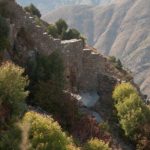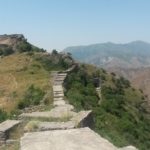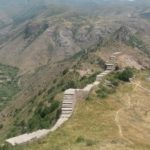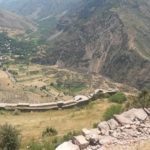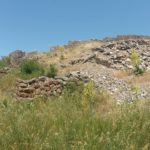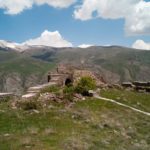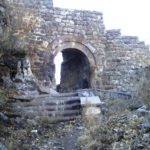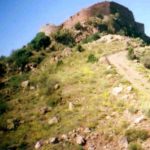«Սմբատաբերդ» ամրոցը, ամենայն հավանականությամբ, կառուցվել է Արշակունիների թագավորության շրջանում։ Համաձայն պատմական տեղեկությունների՝ V դ․ ամրոցի մոտ հայերի և պարսիկների միջև ճակատամարտ է տեղի ունեցել։
Ստույգ հայտնի չէ ամրոցի իրական անունը։ Ժողովուրդը Սմբատաբերդ է կոչում, թերևս XIII դդ․ նշանավոր իշխան Սմբատ Օրբելյանի պատվին, որը գուցե վերակառուցել և ամրացրել է բերդը։ Չի բացառվում, որ ամրոցի անունը կարող է կապված լինել նաև X դ․ Սյունիքի թագավորության հիմնադիր Սմբատ Սյունի իշխանի անվան հետ:
IX դ․ կեսին Սյունյաց իշխանները, Եղեգիսը դարձնելով իրենց վարչաքաղաքական կենտրոնը, ռազմական հենակետ են դարձրել հենց Սմբատաբերդ ամրոցը։ Այն ամրակայվել է Օրբելյանների շրջանում (XIII-XV դդ.), սակայն XVII դ․ ամբողջապես ավերվել է և լքվել՝ Շահ-Աբբասի, ապա թուրք-պարսկական պատերազմների հետևանքով։
Ամրոցը, կառուցվել է միջնադարյան բերդաշինության կանոններով՝ նախատեսված լինելով երկարատև պաշտպանության համար:
Սմբատաբերդ ամրոցը արևելյան և հարավային կողմերից եզերված է Եղեգիսի, իսկ արևմտյան կողմից` Արտաբույնքի գետերի կիրճերով: Մատչելի է միայն հյուսիսային կողմից, որը ամրացված է պարիսպներով:
Ամրոցն ունի մոտ 1 կմ ձգվածություն, կիսաբոլոր աշտարակներով հզոր պարիսպներ, որոնց բարձրությունը հասնում է 8-10 մետրի: Պարիսպները շարված են սեպաձև մշակված բազալտաքարերով՝ կրաշաղախով, սեպի սուր ծայրը դարձրած դեպի պատը, որի հաստությունը 2-3 մ է։ Պարիսպների ներսում՝ նրանց ամբողջ երկարությամբ պահպանվել են բնակելի և տնտեսական կառույցների ավերակներ։
Ամրոցի գլխավոր մուտքը հյուսիսային կողմից է, մեկական մուտքեր էլ՝ արևելյան և արևմտյան կողմերի հյուսիսային ծայրերից: Հյուսիսային և արևելյան մուտքերը սրահավոր են, շարված են սրբատաշ բազալտով՝ և կրաշաղախով, սրահի տանիքին եղել են պահակատներ ու դիտանոցներ:
Ամրոցը մի ընդհանուր պատով բաժանված է հարավային և հյուսիսային մասերի։ Ունեցել է բնակելի շենքեր և ջրի ավազաններ։ Հարավային մասում բնակելի կառույցները միայն միջնաբերդում են եղել:
Սմբատաբերդի ջրամատակարարումն իրականացվել է կավե խողովակներից բաղկացած ջրմուղի միջոցով։ Ջուրը բերվել է Ցախաց քարի մոտի աղբյուրներից, որի ջրմուղի հետքերը նկատվում են լեռնաշղթայի պարանոցի մասում՝ ճանապարհի եզրին:
2011 թ. Սմբատաբերդում իրականացվել են մասնակի վերականգնման աշխատանքներ:
«Սմբատաբերդ» պատմամշակութային արգելոցը 2018 թ․ գործում է որպես «Պատմամշակութային արգելոց-թանգարանների և պատմական միջավայրի պահպանության ծառայություն» ՊՈԱԿ-ի մասնաճուղ։





